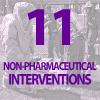


Capability 11: Non-Pharmaceutical Interventions
Definition: Non-pharmaceutical interventions are the ability to recommend to the applicable lead agency (if not public health) and implement, if applicable, strategies for disease, injury, and exposure control. Strategies include the following:
• Isolation and quarantine
• Restrictions on movement and travel advisory/warnings
• Social distancing
• External decontamination
• Hygiene
• Precautionary protective behaviors
Functions and Associated Performance Measures: This capability consists of the ability to perform the functions listed below. At present there are no CDC-defined performance measures for these functions.
Function 1: Engage partners and identify factors that impact non-pharmaceutical interventions
Function 2: Determine non-pharmaceutical interventions
Function 3: Implement non-pharmaceutical interventions
Function 4: Monitor non-pharmaceutical interventions
Isolation and Quarantine: Public Health Emergency Training Module [1]
This is one of nine awareness-level online modules, developed by the University of Minnesota Center for Public Health Preparedness in the UM PHET series, that cover critical topics related to emergency preparedness. This module takes between 20-40 minutes to complete. This training examines the concepts and history of isolation and quarantine, and explains when and how these restrictions are used in a public health context. Participants are eligible to receive up to .05 CEUs .5 contact hours for completion of training including pre-test, post test and evaluation. Learning Objectives - at the conclusion of this training, participants will be able to: Define and distinguish between isolation and quarantine; Explain the history of isolation and quarantine; Describe the requirements of local, state, tribal and federal agencies; Follow state-level procedures for isolation and quarantine. This project was developed by the University of Minnesota Center for Public Health Preparedness.
Decontomination: Public Health Emergency Training Module [2]
This is one of nine awareness-level online modules, developed by the University of Minnesota Center for Public Health Preparedness in the UM PHET series, that cover critical topics related to emergency preparedness. This module takes between 20-40 minutes to complete. This training describes decontamination methods and equipment, and identifies basic principles, standards and regulations for decontamination operations. Participants are eligible to receive up to .05 CEUs or .5 contact hours for completion of training including pre-test, post test and evaluation. Learning Objectives - at the conclusion of this training, participants will be able to: Describe the purpose of decontamination; Identify the standards regulating decontamination; Describe the basic equipment used for decontamination; Distinguish between emergency and technical decontamination; Explain the process for decontamination in emergencies; Prioritize patients for decontamination.
Isolation and Quarantine as a Strategy for a Response to a Public Health Emergency [3]
Isolation and quarantine are traditional tools in containment of infectious disease of contaminated individuals. This training from the TECS-Preparedness and Emergency Response Learning Center provides an overview of the use of isolation and quarantine in order to prevent and control the spread of disease. This eLearning course should take approximately one hour to complete.
Isolation & Quarantine Response Planning Toolkit [4]
In the absence of rapid and definitive diagnostic tests, vaccines, or cures, isolation and quarantine remains Public Health's best strategy against the spread of mass illness. Seattle & King County Public Health is an Advanced Practice Center for Emergency Preparedness and established this Planning for Isolation & Quarantine Response Web Toolkit to support local Public Health jurisdictions in their efforts to plan for and manage a local isolation and quarantine response. The Toolkit is designed primarily for local and county and is separated by topic for the ease of use and navigation.
Virtual Community Reception Center [5]
Following a mass casualty radiation emergency, public health professionals will play a crucial role in assessing and monitoring people potentially exposed to radiation or contaminated with radioactive material. This process, called population monitoring, will be conducted in community reception centers (CRCs). Virtual Community Reception Center (vCRC) is a web-based training tool that provides an overview of the CRC process for planners, managers, and potential CRC staff. vCRC is a self-paced program from the CDC that uses a simulated 3-D environment, embedded video segments, an interactive process flow diagram, and customizable supporting resources to deliver a unique training experience for all users.
Radiological Screening and Decontamination Exercise [6]
From the Center for Infectious Disease Research and Policy (CIDRAP): In the summer of 2011, the Florida Department of Health held a community reception center exercise to test its capacity to respond to a radiological emergency. Years of training responders, purchasing specialized equipment, and developing partnerships led to a successful exercise of such skills as screening and dosimetry, decontamination, and medical triage. State and local health departments across the country have been planning to address radiological threats, whether accidental (eg, incidents at nearby nuclear power plants) or man made (eg, radiological dispersal devices or "dirty bombs"). Following a radiological incident, public health agencies will monitor the affected population for contamination in community reception centers (CRCs). While falling under the purview of public health or emergency management agencies, radiological preparedness is an interdisciplinary endeavor, requiring expertise from industry and the physical/environmental sciences. Downloadable tools include: CRC Form, After-Action Report, and Improvement Plan Matrix.
National Planning Scenarios [7]
The Federal interagency community has developed 15 all-hazards planning scenarios (the National Planning Scenarios or Scenarios) for use in national, Federal, State, and local homeland security preparedness activities. The Scenarios are planning tools and are representative of the range of potential terrorist attacks and natural disasters and the related impacts that face our nation. The objective was to develop a minimum number of credible scenarios in order to establish the range of response requirements to facilitate preparedness planning.
Links
[1] https://cdc.train.org/DesktopModules/eLearning/CourseDetails/CourseDetailsForm.aspx?tabid=62&courseid=1007955&backURL=L0Rlc2t0b3BTaGVsbC5hc3B4P3RhYmlkPTYyJmdvdG89YnJvd3NlJmJyb3dzZT1jb21wZXRlbmN5Jmxvb2tmb3I9bm9kZXM6NTYsNTcsNTgsNTkmY2xpbmljYWw9Ym90aCZsb2NhbD1hbGwmQnlDb3N0PTA=
[2] https://cdc.train.org/DesktopModules/eLearning/CourseDetails/CourseDetailsForm.aspx?tabid=62&courseid=1007952&backURL=L0Rlc2t0b3BTaGVsbC5hc3B4P3RhYmlkPTYyJmdvdG89YnJvd3NlJmJyb3dzZT1jb21wZXRlbmN5Jmxvb2tmb3I9bm9kZXM6NTYsNTcsNTgsNTkmY2xpbmljYWw9Ym90aCZsb2NhbD1hbGwmQnlDb3N0PTA=
[3] https://cdc.train.org/DesktopModules/eLearning/CourseDetails/CourseDetailsForm.aspx?tabid=62&courseid=1042281&backURL=L0Rlc2t0b3BTaGVsbC5hc3B4P3RhYmlkPTYyJmdvdG89YnJvd3NlJmJyb3dzZT1jb21wZXRlbmN5Jmxvb2tmb3I9bm9kZXM6NTYsNTcsNTgsNTkmY2xpbmljYWw9Ym90aCZsb2NhbD1hbGwmQnlDb3N0PTA=
[4] http://www.apctoolkits.com/isolationandquarantine/
[5] http://emergency.cdc.gov/radiation/crc/vcrc.asp
[6] http://www.cidrap.umn.edu/practice/community-reception-center-exercise-tests-floridas-radiological-screening-and
[7] https://secure.nccrimecontrol.org/hsb/planning/Planning%20Documents/National%20Planning%20Scenarios%202006.pdf